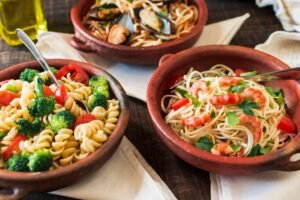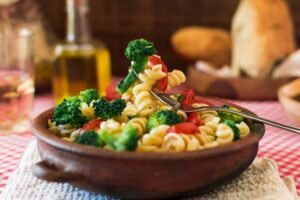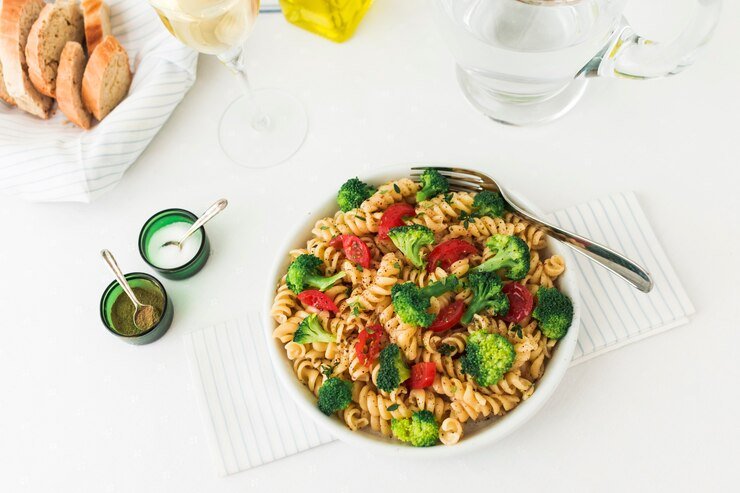Pasta salad is a beloved dish recognized for its versatility and widespread appeal. Typically made with one or more types of pasta, this dish is served chilled and is often tossed in a vinegar, oil, or mayonnaise-based dressing. It is frequently enhanced with various mix-ins such as vegetables, herbs, meats, and cheeses.
The popularity of pasta salad can be attributed to its adaptability. It can be tailored to fit a wide range of dietary preferences and occasions, making it a staple at gatherings like picnics, barbecues, and potlucks. Its ability to be made in advance also adds to its appeal, as the flavors tend to develop more fully as it rests.
Furthermore, pasta salad serves as an excellent vehicle for seasonal ingredients, allowing chefs and home cooks alike to incorporate fresh, local produce. Whether it’s a simple, light version for a summer lunch or a hearty, protein-packed dish that serves as a meal’s centerpiece, pasta salad’s flexibility makes it a favorite across different cultures and cuisines.
Global Popularity of Pasta Salad
Pasta salad is a versatile dish enjoyed in various forms around the world, but it’s particularly popular in certain countries due to its adaptability and ease of preparation. Here are some of the countries where pasta salad is a favored choice:
- United States: In the U.S., this recipe is a staple at picnics, potlucks, and barbecue gatherings. It often features ingredients like mayonnaise, mustard, and a variety of mix-ins such as vegetables, cheese, and meats.
- Italy: While traditional Italian salads more commonly feature fresh vegetables and Mediterranean flavors, pasta salad has been adapted in Italy to include Italian dressing, olives, and sometimes seafood, reflecting local tastes and ingredients.
- Germany: Known in Germany as « Nudelsalat, » pasta salad in this country typically includes a mayonnaise base and is commonly served at outdoor parties and gatherings. It often contains pickles, sausage, or ham.
- Australia: Australians enjoy pasta salad during the warm months and it is a common feature at many outdoor events and family barbecues. Australian pasta salads often include a variety of colorful vegetables and a creamy or vinaigrette dressing.
- Canada: Similar to the U.S., pasta salad in Canada is a popular choice for picnics and casual dining, often featuring a mix of vegetables and creamy dressings, and sometimes incorporating ingredients like maple syrup for a local twist.
Types of Pasta Salad
Exploring Different Styles
Pasta salads are versatile and can be adapted to a variety of tastes and occasions. Here are some popular variations:
Italian Pasta Salad: This staple of picnic menus combines al dente pasta with ingredients like sliced olives, sun-dried tomatoes, diced mozzarella, and cured meats such as pepperoni or salami, all dressed in a hearty Italian vinaigrette. It’s colorful, flavorful, and perfect for any gathering.
Ramen Cabbage Salad: A unique twist on traditional pasta salad, this version uses uncooked crushed ramen noodles for an extra crunch. It’s tossed with shredded cabbage, green onions, and a sweet and tangy dressing, often topped with toasted sesame seeds for an Asian flare.
Bacon Ranch Pasta Salad: This creamy delight mixes pasta with crispy bacon, diced cucumber, and cherry tomatoes, smothered in a rich ranch dressing. It’s a comforting and satisfying choice that’s always a crowd-pleaser at barbecues.
Chicken Caesar Pasta Salad: Marrying the elements of a Caesar salad with pasta, this dish features diced chicken breast, crisp romaine lettuce, and shredded Parmesan cheese, all tossed with a creamy Caesar dressing and served cold. It’s a hearty, protein-packed salad ideal for a fulfilling lunch.
Bow Tie Pasta with Broccoli, Garlic, and Lemon: This light and refreshing salad combines bow tie pasta with steamed broccoli florets, minced garlic, and a dressing of lemon juice and olive oil. It’s simple yet flavorful, with a hint of lemon providing a bright finish.
Each type of this recipe showcases a different set of ingredients and flavors, making this dish infinitely adaptable to your taste preferences and the ingredients you have on hand. Whether you’re looking for something robust and meaty or light and vegetarian, there’s a pasta salad for everyone.
Ingredients and Substitutions
Pasta salad is a flexible dish that can be customized with a variety of ingredients, allowing for endless creativity. Here’s a look at some common ingredients and ideas for substitutions:
Common Ingredients in Pasta Salads:
- Pasta: Shapes like penne, fusilli, or bow ties are popular as they hold dressings well.
- Vegetables: Common choices include bell peppers, cucumbers, tomatoes, and onions.
- Proteins: Grilled chicken, ham, salami, or canned tuna add substance.
- Cheese: Cubes of cheddar, mozzarella balls, or crumbled feta add creaminess and flavor.
- Dressings: Vinaigrettes, mayonnaise-based dressings, or simple oil and vinegar are used to bind and flavor the salad.
Substitutions and Variations:
- Gluten-Free Options: Substitute traditional pasta with gluten-free pasta or go grain-free with zucchini noodles or spiralized vegetables.
- Vegan Variations: Replace meat and dairy products with grilled tofu, vegan cheese, and legumes like chickpeas or black beans.
- Low-Calorie Dressings: Opt for yogurt-based dressings or a simple squeeze of lemon and herbs to reduce calories without sacrificing flavor.
- Add Crunch: Include seeds like sunflower or pumpkin, or nuts like almonds or walnuts for added texture.
- Spice It Up: Introduce spices or spicy elements like jalapeños or chili flakes to give your pasta salad a kick.
By experimenting with these ingredients and substitutions, you can tailor your pasta salad to fit any dietary needs and flavor preferences, making it a perfect dish for any occasion. Whether aiming for a hearty meal or a light side dish, these variations can help transform your pasta salad into a personalized culinary creation.

Preparing the Perfect Pasta Salad
Cooking Tips and Techniques
To make an outstanding pasta salad, consider the following key techniques:
Cooking Pasta to the Right Texture:
- Select suitable pasta shapes like rotini or farfalle, which hold dressing well.
- Salt the water generously before cooking to season the pasta.
- Aim for al dente—cook pasta until tender yet firm, avoiding mushiness.
- Cool the pasta under cold water after cooking to stop the cooking process and prevent sticking.
Choosing the Right Dressing:
- Match the dressing with the salad’s ingredients—light vinaigrettes for vegetable-heavy salads, creamy dressings for richer versions.
- Prepare the dressing ahead to enhance flavor integration.
- Adjust the dressing amount to ensure the pasta is well-coated but not overly soggy, adding more as needed before serving.
Balancing Flavors:
- Incorporate acidity with vinegar or lemon juice to contrast the creaminess of dressings.
- Sweeten slightly if the salad includes bitter components, using honey or sugar.
- Season well with salt and pepper, and add fresh herbs like basil or parsley for a fresh touch.
These tips will help you craft a delicious pasta salad that’s perfectly balanced and enjoyable at any meal.
Recipes
Detailed Recipes and Instructions
Quick Italian Pasta Salad
Ingredients:
-
- 300g fusilli or rotini pasta
- 1 cup cherry tomatoes, halved
- 1/2 cup black olives, sliced
- 1/2 cup mozzarella cheese, cubed
- 1/4 cup red onion, thinly sliced
- 1/4 cup fresh basil leaves, chopped
- 3/4 cup Italian dressing
- Salt and pepper to taste
Instructions:
-
-
- Cook the pasta in salted boiling water until al dente, then drain and rinse under cold water.
- In a large bowl, combine the cooked pasta, cherry tomatoes, olives, mozzarella, and red onion.
- Pour the Italian dressing over the salad and toss to combine.
- Season with salt and pepper, and sprinkle with fresh basil before serving.
- Chill for at least 30 minutes before serving to allow flavors to meld.
-
Magnificent Macaroni Salad
Ingredients:
-
- 300g elbow macaroni
- 1 cup mayonnaise
- 1 tablespoon mustard
- 1/2 cup celery, finely chopped
- 1/4 cup carrot, grated
- 1/4 cup green bell pepper, diced
- 2 tablespoons onion, minced
- 1 tablespoon vinegar
- 1 tablespoon sugar
- Salt and pepper to taste
Instructions:
-
- Cook the macaroni in salted boiling water until al dente, then drain and cool.
- In a small bowl, mix the mayonnaise, mustard, vinegar, and sugar to create the dressing.
- In a large bowl, combine the cooled macaroni with celery, carrot, bell pepper, and onion.
- Add the dressing to the macaroni mixture and toss until well coated.
- Season with salt and pepper to taste.
- Refrigerate for at least one hour before serving to develop the flavors.
Low-Carb Zucchini Pasta
-
Ingredients:
- 4 medium zucchinis, spiralized
- 1/2 cup cherry tomatoes, halved
- 1/4 cup pesto sauce
- 1/4 cup parmesan cheese, grated
- Salt and pepper to taste
- Optional: grilled chicken strips or shrimp for protein
-
Instructions:
- Using a spiralizer, turn the zucchinis into noodles and place them in a large bowl.
- Add the cherry tomatoes and pesto sauce to the zucchini noodles and toss to combine.
- Season with salt and pepper, then sprinkle with grated Parmesan.
- If adding protein, top the pasta with grilled chicken or shrimp.
- Serve immediately or chill briefly to enhance the flavors.
These recipes provide a variety of options, from a classic pasta salad to a healthier low-carb alternative, ensuring there is something for every taste and dietary preference. Enjoy crafting these delicious, vibrant pasta salads that are perfect for any occasion.
Nutritional Information
Health Aspects
Pasta salad can be both a delicious and nutritious dish when prepared thoughtfully. Here are the nutritional benefits and tips for crafting a healthier version:
Nutritional Benefits of Pasta Salad:
- Variety of Nutrients: Pasta salads often include a mix of vegetables, providing vitamins and minerals essential for health. Adding proteins like chicken or beans enhances the dish with iron and fiber.
- Energy Source: Pasta is a good source of carbohydrates, offering energy, especially when whole grain pasta is used.
Tips for Making Healthier Pasta Salad:
- Opt for Whole Grain Pasta: Switch out regular pasta for whole grain options to increase dietary fiber and keep you fuller longer.
- Increase Vegetables: Boost the amount and variety of vegetables in your salad to up the fiber and nutrient content without adding many calories.
- Use Healthier Dressings: Consider dressings based on olive oil and vinegar or yogurt instead of mayonnaise-based ones to reduce calorie intake and add healthy fats.
- Add Lean Proteins: Incorporate lean proteins like grilled chicken, tofu, or legumes to make your pasta salad more filling and nutritionally balanced.
By focusing on these aspects, pasta salad can be part of a balanced diet, offering both taste and health benefits.

Frequently Asked Questions
1. What type of pasta is best ?
Short pasta shapes like fusilli, penne, and rotini are popular choices for pasta salad because their shapes hold onto dressings and seasonings well. They also mix nicely with other ingredients without breaking apart.
2. Should I rinse the pasta after cooking it?
Yes, it’s recommended to rinse pasta under cold water after cooking when making pasta salad. This stops the cooking process and removes excess starch, which helps prevent the pasta from becoming sticky and clumping together.
3. What dressing is best?
Vinaigrettes and Italian dressing are commonly used because their acidic and flavorful nature enhances the salad without overpowering the other ingredients. Creamy dressings like mayonnaise or ranch are also popular, especially in American-style pasta salads.
4. Can pasta salad be made ahead of time?
Pasta salad can be made ahead of time and often tastes better after the flavors have melded together in the refrigerator. However, if your salad includes ingredients that wilt easily, such as fresh leafy greens, add those just before serving.
5. How long can pasta salad be stored in the refrigerator?
Pasta salad can typically be stored in the refrigerator for up to 5 days. Keep it in airtight containers to maintain freshness and prevent it from absorbing other flavors from the fridge.
6. Is pasta salad healthy?
Pasta salad can be healthy depending on the ingredients used. Using whole grain pasta, lots of vegetables, and a light dressing can make it a nutritious option. However, heavy dressings and additional high-calorie ingredients like cheese and cured meats can increase the calorie count.
7. Can I add protein to my salad?
Yes, adding proteins like grilled chicken, tuna, chickpeas, or tofu can make pasta salad more filling and balanced. This is an excellent way to turn a simple pasta salad into a complete meal.
8. What are some good vegetables to add to pasta salad?
Common vegetables include cucumbers, tomatoes, bell peppers, onions, and olives. For a crunch and a bit of sweetness, you might also consider adding raw broccoli, carrots, or corn.
External Links and Anchor Texts
- Tastes Better From Scratch (Italian Pasta Salad)
Pasta salad exemplifies versatility and appeal, offering endless variations to suit any taste or occasion. From hearty meals featuring creamy dressings and robust ingredients to light, healthy options brimming with fresh vegetables, there’s a salad for everyone. This guide encourages you to embrace the art of pasta salad making by experimenting with different ingredients, dressings, and techniques. Dive into creating your own unique recipes and discover the joy of crafting dishes that are both delightful and satisfying.

